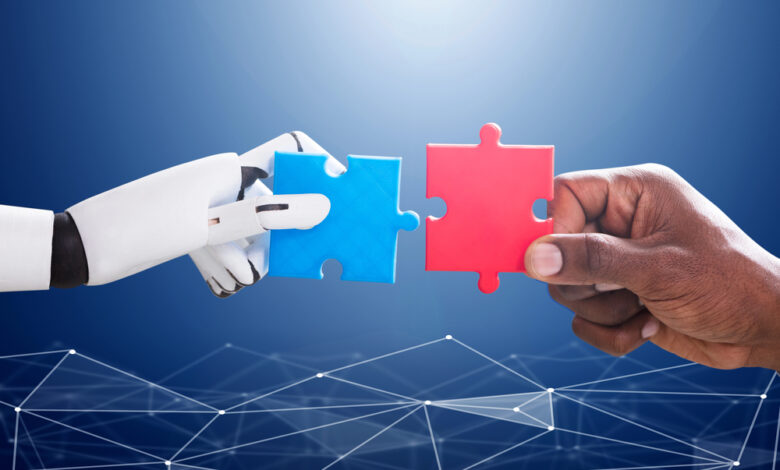
“The only way to make sense out of change is to plunge into it, move with it, and join the
dance,” was once said by Alan Watts. That‘s the quote I think of when thinking about how
human–AI collaboration defines the workplace. Like anything new, there is a bit of fear
before we understand things.
Embracing the AI Revolution
We’ve seen it with electronics and digital technology in the third industrial revolution, the use of electricity for mass production in the second industrial revolution, and mechanical production in the first industrial revolution. This is the case for innovative businesses so far in this fourth revolution, with the integration of AI. These organizations are moving beyond automation to enable meaningful collaboration between employees and intelligent systems. Gartner has even stated that by 2026, 25% of employee tasks will be augmented by AI, not replaced by it.
Augmentation Over Automation
We’re seeing law offices adopt tools like Harvey to summarize large volumes of legal files, allowing lawyers to focus their attention on more impactful work on the strategy side. More healthcare organizations are utilizing AI to diagnose patients earlier, enabling doctors to allocate more time to patient care and develop personalized plans of action for their patients. Even marketing firms like ours are adopting approaches where we see AI as more than just a tool for repetitive rules-based tasks, but more of an augmentation where AI can generate initial drafts of ad copy and campaign data analysis, and our account management team focuses on key human elements such as storytelling, creative direction, and nuanced client engagement. But how should innovative organizations train their teams to have effective human-AI collaboration?
Frameworks for Effective Human-AI Collaboration
It lies within a couple of frameworks, including the Human-in-the-Loop Model and the TIDE (trust, integration, data, enablement). With HITL verticals that rely on accuracy, such as healthcare and finance, humans are at the forefront of validating AI outputs before companies fully commit to the execution portion. Specifically, humans train machine learning models and provide feedback and annotations to them.
Keeping Humans in Control: Human-in-the-Loop Model
Google has been a significant adopter of this approach, as reflected in several Google Cloud pages and in content in general, where human reviewers validate automated flags related to harmful content. Bloomberg also employs a similar approach, where editors review summaries before publication. In the healthcare field, IBM Watson Health utilizes HITL with diagnostic tools to ensure that doctors have final approval on recommendations. In summary, HITL maintains a human presence at each critical decision-making phase.
Operationalizing AI Collaboration with the TIDE Framework
The TIDE framework is a bit looser. With T, which stands for truth, it’s all about an organization training team members on AI limitations and the importance of humans in AI to build trust. The I, which stands for integrations, involves syncing AI into everyday workflows to avoid a silo of team members who use AI while some colleagues don’t. D, which stands for data, is all about ensuring that any relevant data fed into AI tools is clean and as accurate as possible, and E, for enablement, is about training teams consistently on the evolution of tools and processes.
Building AI Fluency with TIDE
Probably the most well-known company to adopt a TIDE framework is Microsoft, through its integration of Copilot into the Office suite, where Microsoft leverages user trust and training to improve Copilot. In the field of marketing, agencies that fully embrace AI are discovering this valuable method for enhancing AI-driven paid media campaigns, and our company has also begun to move in this direction during the early phase of adaptation. In summary, TIDE facilitates scalable collaborations between humans and AI in day-to-day workflows. Now that we have use cases of human-AI collaborations and a couple of frameworks, how should your organization make things sustainable?
Rethinking Roles in AI and Reskilling
It’s up to the management teams to stay abreast of changes and redefine roles with companies. The elephant in the room is that today’s jobs might not exist tomorrow. But like any industrial revolution, new roles are created. The roles that will likely be designed for human-AI collaboration are those that move away from rote tasks and toward high-order thinking. At its core, that means investing in digital literacy and AI fluency, experimenting with consistent feedback loops between teams on tools, and understanding that humans’ roles in effective collaboration with AI will lie in ethics, empathy, creativity, and strategy.
The Road Ahead
As the AI gold rush continues to evolve and become more advanced, the need for collaboration will also change. Companies will need to have leaders who foster transparent governance among teams, adopt ethical standards, and ensure proper human oversight to avoid common failures. The organizations that will set the paradigm for this won’t be the ones with the most automation; however, they will be the ones where humans and machines work together in a seamless, safe, and effective manner. So, who’s ready to plunge into it, move with it, and join the dance?





